What do you do when you need some piece of information at work? Do you spend hours trying to find it across several different platforms while your patients, customers, or employees are impatiently waiting?
Or does a simple search in your company’s knowledge management system do the trick?
Could it be that knowledge management (KM) is the perfect solution to faster problem-solving and data storage?
Let’s take a closer look at the latest knowledge management statistics and learn more about the current state and the importance of proper KM.
- Global knowledge management market size is expected to reach $2.1 trillion by 2030.
- 44% of experts agree that generative AI is the most important technology for KM.
- 80% of customer support agents say “better access to other departments’ data would improve their work”.
- 54% of organizations use “more than 5 different platforms for documenting and sharing information”.
- 47% of average professionals spend 1-5 hours a day searching for specific information.
- 58% of executives and managers disperse the information through email.
- 83% of decision-makers plan to invest more in data integration over the next year.
- 46% of executives and managers agree that it “takes too long to onboard new employees”.
- 33% of customer service managers believe their agents can easily find the information needed to assist customers.
- 51% of executives state “they would benefit from a visual diagram/search capability enabled by visual tools”.
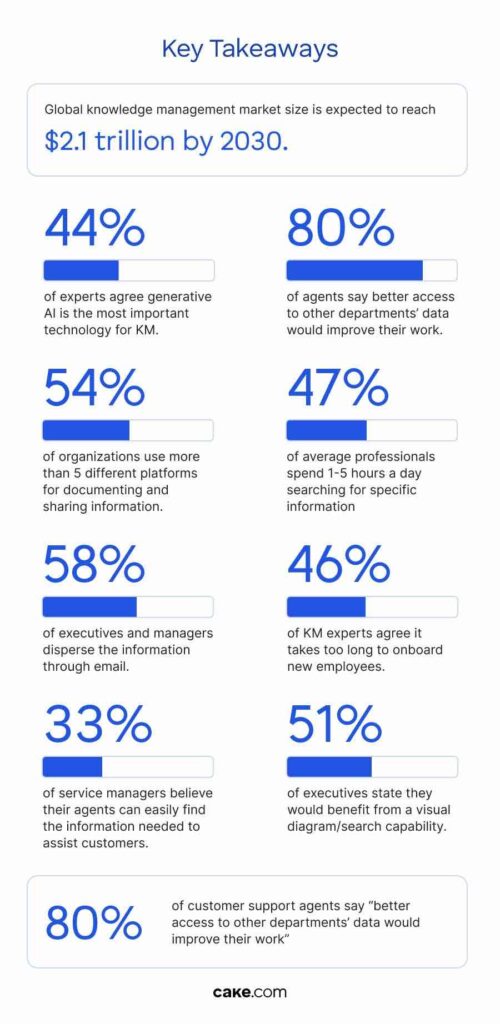
The current state of knowledge management and its top priorities
The global knowledge management market is forecasted to reach $2.1 trillion by 2030. For comparison, the current size is approximately $773.6 billion.
But what exactly is knowledge management? It’s all the platforms and applications a company is using to enhance knowledge management and sharing among employees.
The faster employees are able to find what they’re looking for, the faster they’ll find the solution to any issue.
Knowledge management is a vital addition in the HR industry, as well as in customer service, IT, and healthcare. However, any industry and any company would benefit from having knowledge organized and easily accessible to employees.
According to the latest APQC knowledge management survey, currently, 44% of KM experts (knowledge workers for whom the survey doesn’t mention the industry in which these workers belong) agree that the main priority for KM is operational efficiency/process enhancement.
These digits speak highly of the need for efficient systems that enable employees to find specific information.
Let’s take a closer look at the top business priorities for KM, the top priorities for KM teams in general, and KM’s present state.
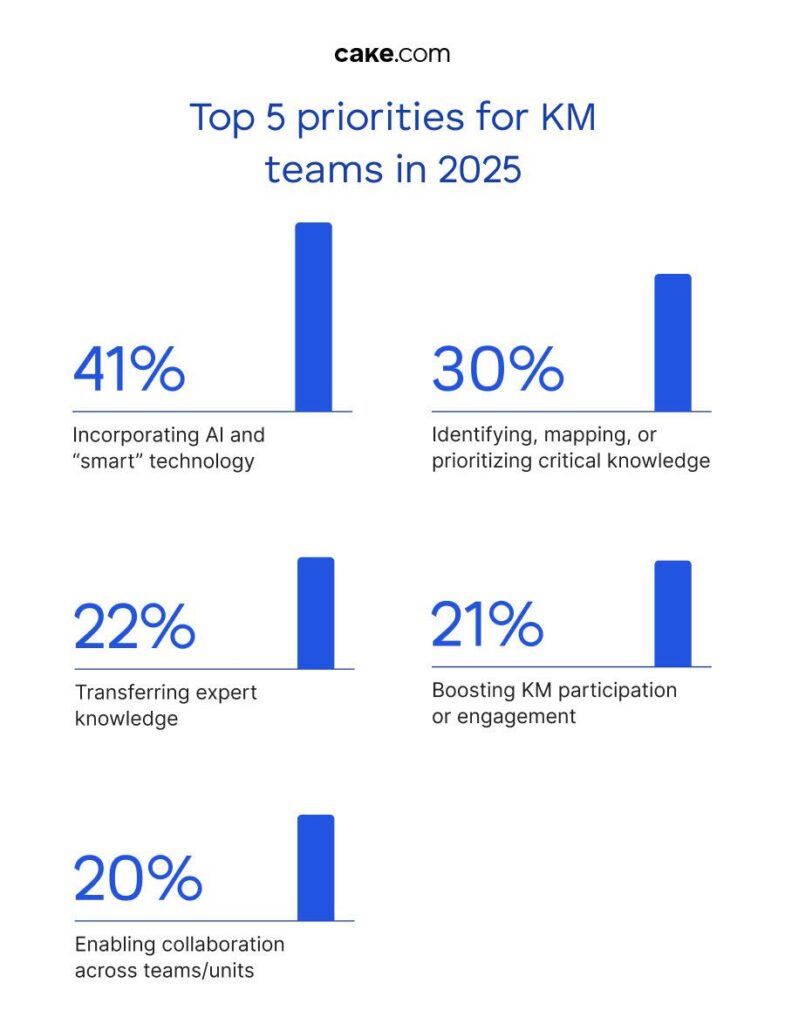
55% of KM experts believe knowledge management is gaining ground
The same APQC research reveals that 55% of respondents believe knowledge management is gaining ground. Another 23% say it’s in a steady state, whereas 10% claim it’s thriving. At the same time, 9% see KM in decline, whereas a small percentage (3%) believe it’s in freefall.
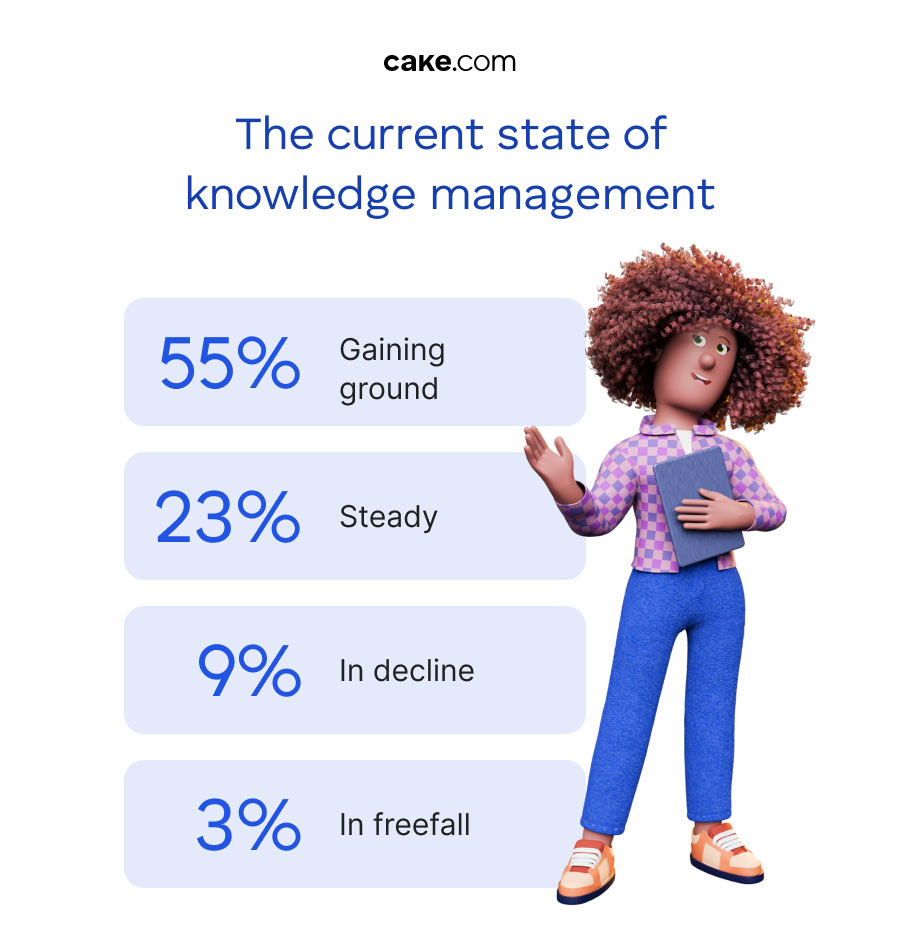
41% of experts find that incorporating AI is a key KM teams’ priority in 2025
AI and “smart technology” are a priority for KM teams, according to 41% of experts participating in the APQC survey.
In the future, we can expect KM tools to implement more AI features. This would complement KM systems in a way that would ensure easier knowledge sharing, storing, and even creating.
Other major priorities include “identifying, mapping, or prioritizing critical knowledge” (30%) and “transferring expert knowledge” (22%).
Critical knowledge is unique for every company — it represents the know-how knowledge of all the procedures and strategies vital to running the business. This can be the company’s standard operating procedures (e.g., information about working hours, company benefits, and paid time off rules) or specific data about the company’s product or service.
On the other hand, expert knowledge is in-depth knowledge of a certain area, such as legal, accounting, or logistics. And for a business to thrive different departments must share and transfer expert knowledge efficiently.
Further reading:
Learn all about PTO plans and policies, and how PTO differs from vacation in the following blog:
44% of experts find that generative AI is the most important technology for KM
According to the same research, 44% of respondents find that “generative AI is necessary to create new artifacts and content for KM”.
Another 39% believe that “AI is vital in recommending content or knowledge assets”.
Generative AI has a wide application range. It can assist in correcting errors, removing outdated information from KM systems, and adding context to knowledge articles.
Additionally, it can create summarized content about a certain topic which can make searching for information much easier. For example, if the HR and Facility departments have policies about guest visitors to the company — Gen AI can create a single article that would combine information from both the HR and Facility aspects.
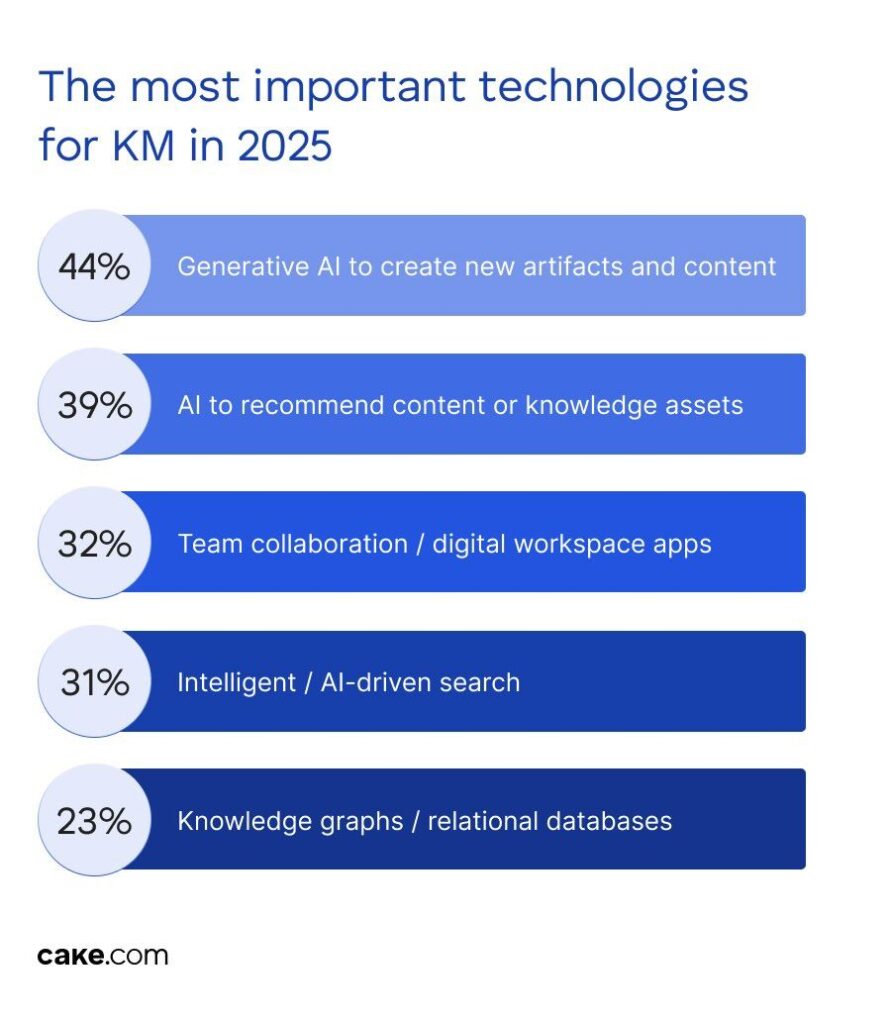
Further reading:
One can’t help but wonder, can AI resolve our issues without it taking a toll? Read more about AI burnout right here:
How companies around the world implement knowledge management processes in their work
Ideally, we should be able to extract the specific piece of information we need within minutes. But let’s see whether this is the case in companies around the world.
54% of organizations rely on more than 5 different platforms to document processes or share information
The latest KM World Survey Report reveals that 54% of organizations use “more than 5 different platforms for documenting and sharing information” among employees.
This causes employees to spend more time searching for specific information, thus decreasing efficiency.
A similar eGain study on knowledge management found that 36% of participants have 3 or more KM tools in use, with 31% of employees not knowing how many KM tools they even have.
26% say they’re dissatisfied with their current KM solutions, and 55% are somewhat satisfied. This indicates that there’s plenty of room for improvement in knowledge management systems within organizations.
Also, according to the Salesforce report, “58% of agents at underperforming organizations toggle between multiple screens to find what they need — compared to 36% at high performers”.
47% of employees spend 1-5 hours a day searching for specific information
The latest Pryon report shows that 47% of average professionals spend 1-5 hours a day searching for specific information. Another 15% spend 6-10 hours doing the same, whereas the same number (15%) say they spend less than 1 hour finding what they need.
The findings of these reports undoubtedly point out that currently, employees don’t have an efficient knowledge management system to lean on. That’s why they spend hours searching for the right information to complete their tasks. The solution may very well lie in the adoption of an efficient KM system.
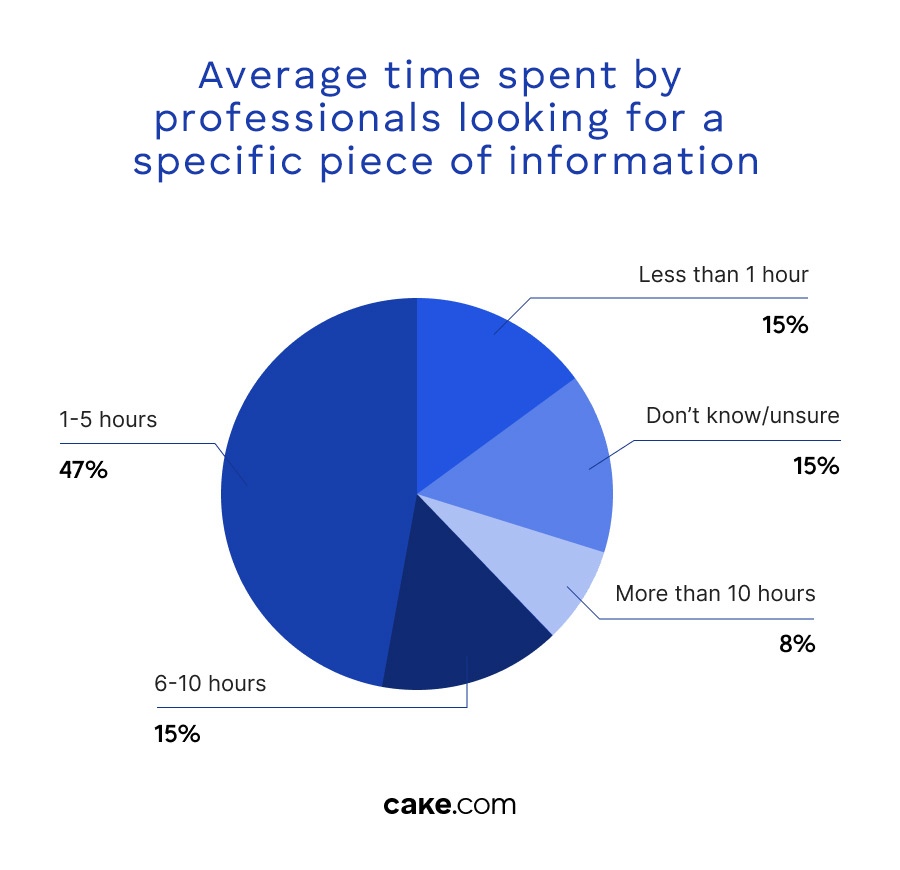
37% of respondents find 51-75% of unstructured information available
The same report asked respondents how easy they can find relevant information about their company, such as policies, procedures, or knowledge articles.
37% responded that 51-75% is available, while 23% responded that they can find 76-99% of the information.
Only 6% responded that 100% of unstructured information is “easily accessible”.
A vast majority (92%) of respondents from the same survey agree that “access to fast and accurate information from unstructured content is vital to their business”.
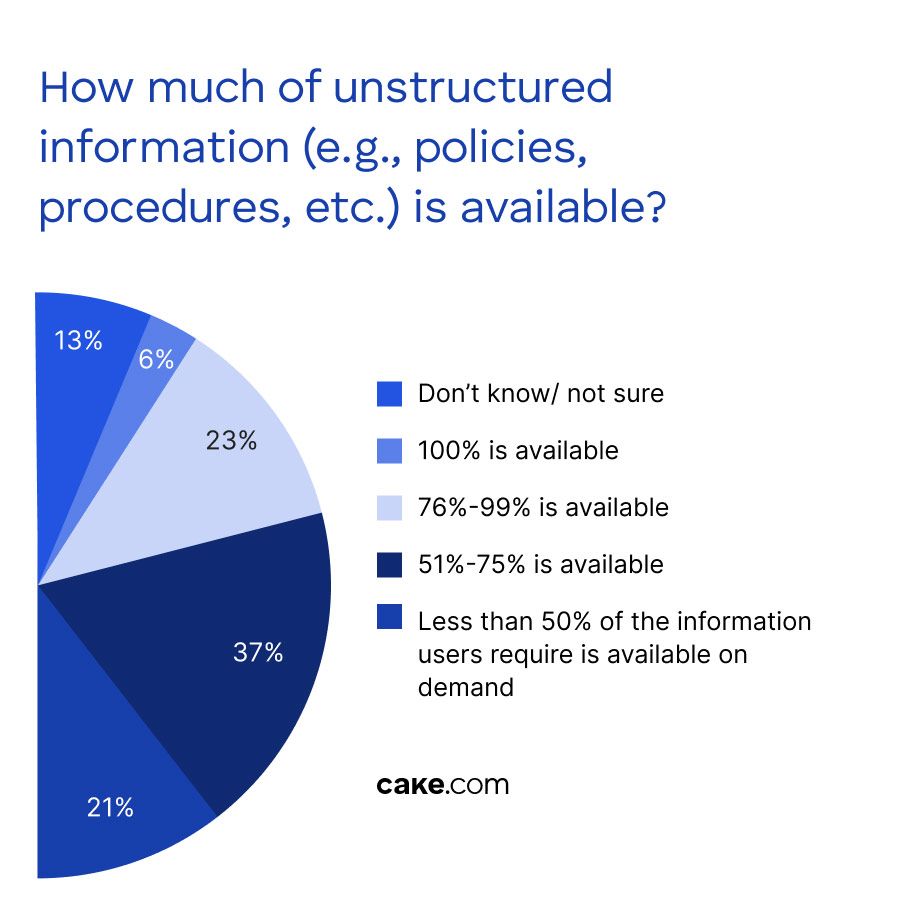
What do managers think of knowledge management?
The latest Visier Research shows that 80% of managers experience at least one pain point when pulling data to make decisions about employees.
These decisions include hiring and promoting employees, boosting employee morale and engagement, and increasing employee productivity.
The information managers want access to includes:
- Performance reviews,
- Employee performance data (like employee scorecard),
- Individual employee compensation, and
- Recruitment performance data.
Currently, 43% of managers say data is “difficult to assess and time-consuming”, 34% say “data is time-consuming and difficult to interpret”, and 32% agree data is “outdated, incomplete, and/or inaccurate”.
This state is a direct consequence of inefficient knowledge management systems, which would enable easier access to data.
37% of business leaders and employees expect to adopt machine learning
According to the Inside the Workplace Report, 37% of business leaders and employees expect to adopt machine learning. This type of learning “enables computerized systems to leverage large data sets to learn and get better at their appointed tasks”.
For example, machine learning is fantastic for analyzing data and making predictions. It can analyze customers’ behavior enabling managers to create strategies and responses that would better fit the customers’ needs.
58% of executives rely on email to disperse the information
The aforementioned KM World Survey Report reveals that employees choose email rather than a knowledge database to find the necessary information.
Specifically, 58% of executives and managers disperse the information through email, compared to 47% who use a knowledge database.
Further reading:
Once the pioneers of business communication, emails are becoming outdated with every passing day. Here’s why:
33% of customer service managers believe their agents can easily find necessary information
As per Deloitte’s Customer Service Excellence report, 33% of customer service managers believe their agents can easily find the information needed to aid customers.
58% find it moderate, whereas 9% find it difficult to find information.
51% of executives state they would benefit from a visual diagram/search capability
According to the KM World Survey Report, 51% of the respondents state “they would benefit from a visual diagram/search capability to better deliver information across their enterprises”.
Similarly, “58% say their training processes could be accelerated from a visual diagram or search capability”.
Another 54% agree that “adding a visual diagram or search capability would accelerate efforts to acquaint employees with changes in business processes”.
48% believe when employees leave, they take valuable information with them
Almost half of the executives and managers who took part in the KM World Survey Report (48%) agree that employees take knowledge about procedures with them once they leave the company.
For example, if you own an IT company that doesn’t have extensive how-to content (about company mission, guidelines, and goals), once your experienced employees leave, the inexperienced ones won’t know how to continue writing code or repairing bugs.
And 49% say decision-makers don’t have a full view of the knowledge base.
Documenting and storing knowledge in a way that is easily accessible to team members is crucial for preventing the loss of information and making well-informed decisions.
Further reading:
Check out how knowledge management and sharing can contribute to enhancing the company’s resilience:
Knowledge management in the customer service industry
Knowledge management is particularly useful in customer service, where the quick resolution of customers’ inquiries is highly praised.
78% of CRM leaders say that customers prefer to solve issues independently
According to the latest Hubspot Customer Service Report, 78% of CRM (customer relationship management) leaders state that customers prefer to solve issues on their own. This is why it comes as no surprise that 68% of them “will prioritize independent customer service solutions”.
Similar data was collected in Salesforce’s latest survey, where 61% of customers reported they would rather use self-service for simple issues.
Since customers prefer resolving their issues through self-service, an ideal response from companies would be creating up-to-date FAQs, tutorials, help pages, and similar articles that would enable this.
28% of customers report they’d rather quit trying to solve a problem than have an agent assist them
A recent Gartner customer service support survey reveals that 28% of customers are “most likely to quit trying to solve a problem with a product or service rather than reach out to an agent for help”. What they want is to be able to find solutions online.
In fact, the same study found that 38% of Millennials and Gen Z customers report having a “self-service or no service mindset”.
Knowledge management is one of the major reasons for both scenarios when customers are and aren’t able to find solutions on their own.
For example, the Salesforce survey we mentioned states that self-service resolves around 54% of customer issues. Now, imagine if customers had access to updated help pages, tutorials, and step-by-step instructions — this number could significantly grow.
Further reading:
Speaking of Gen Z, check out their attitudes toward work in the following article:
62% of agents say materials are outdated
Here’s what agents say about possible reasons why customers aren’t able to solve all of their issues through self-service inquiries, according to the same Salesforce survey:
- 62% of agents say materials such as help pages are not up-to-date,
- 59% of agents claim “instructions are often too complicated to follow”, and
- 65% of agents say “customers’ issues are often too unique”.
And even when customers reach out to customer service agents, things do not always go smoothly.
Namely, “79% of customers expect consistency across departments, but 56% have to repeat information to different representatives”.
At the same time, “80% of agents say better access to other departments’ data would improve their work”.
We can conclude that the key to solving customers’ issues and customers being able to solve issues on their own is having up-to-date materials available across departments. This is why it comes as no surprise that “83% of decision-makers plan to invest more in data integration over the next year”.
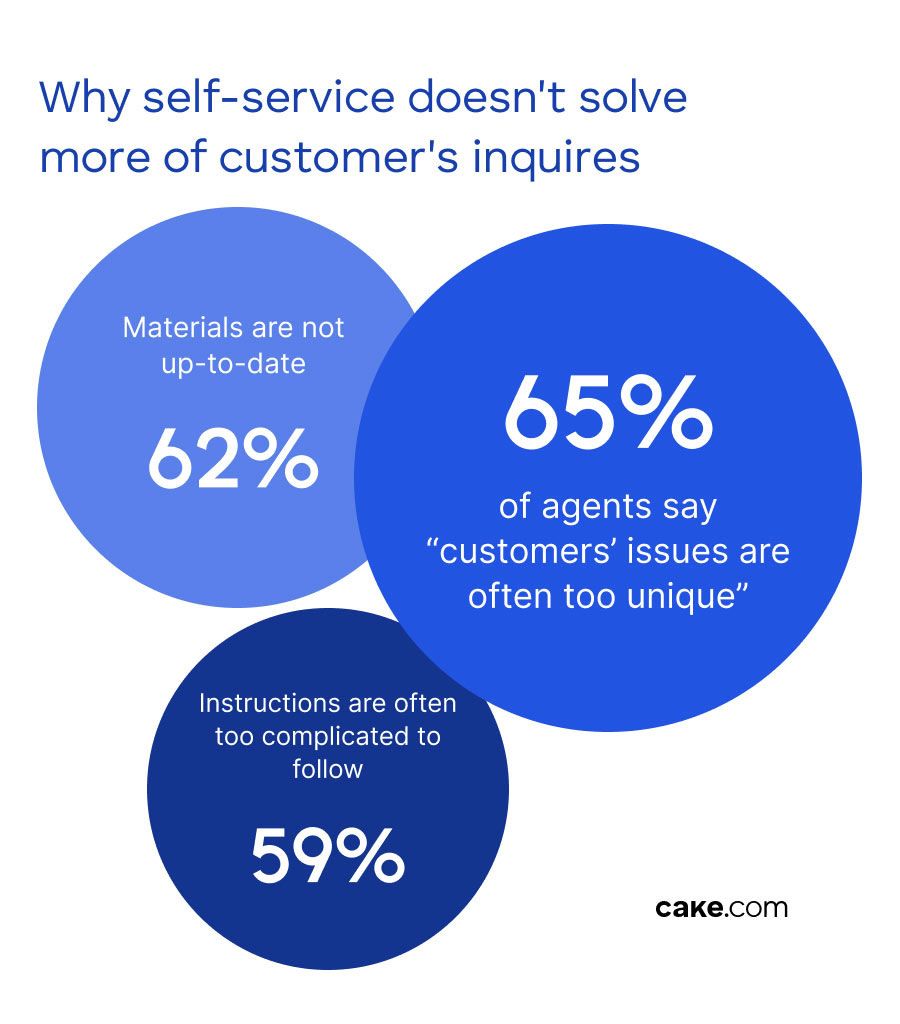
Further reading:
Team collaboration has many benefits, one of which is knowledge sharing. Read all about it here:
Knowledge management and onboarding
Another area where knowledge management can dominate is onboarding, but also training and retaining new hires. Let’s see the latest stats from this field.
46% of KM executives and managers agree it takes too long to onboard new employees
The KM World Survey Report we mentioned shows that, to fully train newly hired employees, 39% of the respondents need more than 3 months.
Almost half of the respondents (46%) agree that it “takes too long to onboard new employees with needed knowledge”.
44% claim that the time to train new hires has increased in the past five years, with one of the main reasons being additional tools or software to learn (57%).
On the other hand, 22% of the respondents claim that the time to train new hires has decreased in the past five years.
The main reasons for this decrease are more user-friendly systems or interfaces (48%), and ramped-up training and onboarding processes (63%).
We are witnessing a rise in the number of tools and processes employees need to use. Therefore, it is paramount to enhance the onboarding process by implementing an efficient KM system that would make it easier for new hires to perform tasks.
Further reading:
Great onboarding is vital for future team productivity. Learn more about it here:
Knowledge management in healthcare
As per C8Health research on knowledge management in hospitals, half of hospital administrators find their knowledge management solutions outdated.
At the same time, only 21% of respondents reported they find what they’re looking for 100% of the time.
Moreover, 13 out of 100 patients get injured or die due to a lack of access to clinical resources. How does this happen, you may ask?
When healthcare professionals aren’t able to find information in the hospital’s guidelines and protocols, they look up information in external resources, which aren’t always in line with the specific institution’s protocols. Lack of information, and acting on wrong information leads to unstandardized care, while the patients bear the consequences.
So, having a reliable KM system is paramount, especially in life-saving institutions such as hospitals.
Further reading:
Burnout in healthcare is on the rise. Read on to find out how to prevent it:
Key knowledge management threats
The APQC research we mentioned shows that one of the main threats of KM is that “employees are overworked and don’t have time for knowledge management” (42%).
This is followed by 41% of experts recognizing that “KM’s impact is hard to measure”.
Another threat, as viewed by 39% of experts, is that “leaders are focused on (what they see as) more urgent problems and opportunities”. Furthermore, 38% believe that “organizational culture does not incentivize knowledge sharing and reuse”.
Lastly, 37% recognize a different type of threat — “people dealing with a lot of change, which makes it harder to motivate new behaviors”.
The current state of knowledge management and what lies ahead
A reliable knowledge management system is one of the core pillars of success in almost any industry.
From healthcare, customer service, HR, or IT — all knowledge workers need to have fast access to the newest information which they’ll be able to use accordingly.
Currently, outdated materials and data dispersed across various departments represent the main pain points for knowledge workers.
Finally, we’re witnessing an increasing number of companies investing in knowledge management, which speaks volumes about recognizing its potential and the benefits it has to offer.
In the future, we can expect a significant rise in the global knowledge management market size.
How we reviewed this post: Our writers & editors monitor the posts and update them when new information becomes available, to keep them fresh and relevant.



